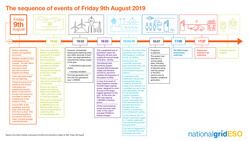News Release from windfair.net
Wind Industry Profile of
UK Investigates National Power Outage
British energy regulator Ofgem investigates whether power companies RWE and Ørsted breached their licence conditions as two of their power stations were involved in the incident on August, 9th where the UK was hit by a large power outage. One of the power plants involved is the 1.2 GW Hornsea 1 Offshore Wind Farm off the coast of Yorkshire which is run by Ørsted and the other being the Little Barford Combined Cycle Power Plant (CCGT).
Grid operator National Grid said in a preliminary report that a lightning strike at 16.52 originally caused the incident, setting in motion the following occurences. The protection systems operated immediately, disconnecting and clearing the disturbance on the line in under 0.1 seconds. The line re-set itself and returned to normal within c.20 seconds. "We are very used to dealing with lightning strikes and handle over 1,000 a year with no loss of customer supplies", the report says. There was a small loss of embedded generation (500 MW) due to the lightning strike which is normal and expected for a lightning strike on a transmission line.
However, immediately following the lightning strike, and within seconds of each other, two large generators reduced their energy supply to the grid: Little Barford gas power station and Hornsea windfarm. The total generation lost from the two generators was 1,378 MW. In case of an event of large frequency change, the ESO keeps backup power, designed to cover the loss of the single biggest generator to the grid. At this time, the ESO was keeping 1,000 MW of backup power and all the normal backup power and tools were used. In this case it included 475 MW of battery storage. However, the scale of the generation loss meant the frequency continued to fall - to 48.8Hz. At this point, the automatic secondary back up system (the Low Frequency Demand Disconnection scheme) kicks in. Customers on the distribution network are automatically disconnected to ensures the safety of the network in a controlled way and in line with parameters pre-set by the distribution network operators (DNOs) – the regional power companies who take the electricity from the grid and move it through their own network of power lines and underground cables. In this instance, 5% of Britain’s electricity supply (c. 1 million customers) was turned off to protect the other 95%. This has not happened in over a decade and is an extremely rare event.
At the still-under-construction offshore wind farm (which is already exporting electricity), the protective safety systems activated. Following an initial review, adjustments to the wind farm configuration, and fine tuning its controls for responding to abnormal events, the wind farm is now operating robustly to such millisecond events, as Ørsted reported to National Grid.
The incident is still under investigations by the various authorities involved. Nevertheless, RenewableUK’s Deputy Chief Executive Emma Pinchbeck said: “We welcome the clarity provided by National Grid’s report to Ofgem that the cause of the power cut was a lightning strike which affected two power stations. National Grid has stated that the outage had nothing to do with the variability of renewables. To ensure our power system is as robust as possible going forward, we need to upgrade our old infrastructure so that we have a grid fully fit for the energy transition and which makes the most of cheap flexible, renewable technologies".
Commenting on the report Tom Edwards Senior Modeller at Cornwall Insight, said: “This initial report highlights several reasons behind this rare event. The event itself was caused by settings and sensor issues in response to a lightning strike. Wind power was not directly responsible for the outage. National Grid was holding 1GW of response* to cover the immediate consequence of the largest in-feed loss of electricity at the time (the Interconnectors), but the overall loss of transmission connected generation was over 1.3GW. In addition, an estimated 500MW of generation capacity was lost on the distribution system at the same time as the lightning strike."
- Author:
- Windfair Staff
- Email:
- press@windfair.net
- Keywords:
- UK, power cut, transmission line, RWE, Ørsted, electricity, outage, investigation, Ofgem, RenewableUK, lightning, National Grid, Cornwall Insight, comment, Hornsea, offshore, wind farm








